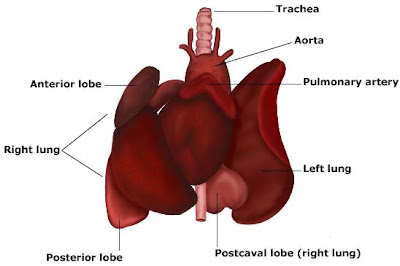veterinary online-Research Respiratory animals
Research Respiratory animals
Research Respiratory animals
Respiratory diseases are widespread among animals, especially young animals. In their study primarily set respiratory rate for 1 min, type, rhythm and symmetry, presence or absence of wheezing and coughing. At rest in adult animals breathing frequency for 1 min is: cattle 12 - 30, a horse 8 - 16, in sheep and goats 16 - 30, in pigs 15 - 20 in dogs 14 - 24, cat 20 -30.
 |
| respiratory system |
Rapid breathing observed in many diseases involving abnormal gas exchange (edema, inflammation and emphysema, rhinitis and bronchitis, anemia, cardiovascular disease, etc.)In most animals (except dogs) chest and abdominal wall take equal part in the respiratory movements (hrudobryushnoy breathing).
frequent manifestation of disorders of the respiratory rhythm is shortness of breath. There vdyhatelnye, vydyhatelnyh and mixed breathlessness.
 |
| Respiratory animals |
When the lungs are used comparative percussion. Topographic percussion conducted to determine the posterior border of the lungs.
Auscultation of the lungs allows you to compare the character of respiratory sounds (rales, splash, friction noise, etc.) Rattling different character appearing in bronchitis, pneumonia, pulmonary edema and congestion. Murmurs occur when inflammation of the pleura with fibrin deposits on it, education connective tissue scarring, adhesive processes.




